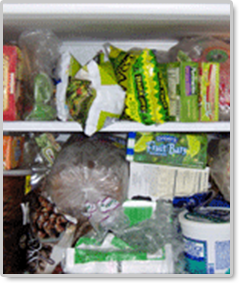Freezer Best Practices

Organizing Items
Properly organizing the items in your freezer can help your freezer operate more efficiently. Here are some tips on how to best organize the items in your freezer:
A full freezer operates more efficiently than in a less full freezer.
This may seem counter-intuitive. It would seem that less food in your freezer would mean less energy, right? Well, it’s actually just the opposite. When your freezer is full, the items inside it help to keep the other items cold so your freezer’s motor doesn’t have to work as hard. A trick to help keep your freezer full is to store bags of ice inside it (helpful accessory: freezer bags).
Use a portable wire cabinet shelving.
At most home goods stores you can find a small portable wire shelving that you can put in your freezer to help organize your food and maximize the airflow around individual items. This will help the items in your freezer to freeze faster, which helps it to save energy.Ensure adequate clearance at the back of your freezer.
The area at the back of your freezer is where the air blower and return air vents are located. If you cram too much food against the back of your freezer, it prevents good air circulation, which reduces the efficiency of the operation of your freezer.
The rear center is the coldest spot in your freezer.
So for items that you will don't plan to use for a while, or that you need to be frozen the most solid, the rear center of your freezer is where you want to place these items.Freezer door shelves are the warmest spot in most freezers.
Because your freezer doors are the warmest spot, this makes them a good place to store frequently used items and foods that are less prone to spoiling, such as coffee beans, bread, butter, and nuts.
Storing Items
Properly preparing the food that you plan to store in your freezer can help prevent losing foods to “freezer burn.” Steps you can take include:
Wrap foods very well to prevent freezer burn dehydration.
The cold air in your freezer is very dry, and if your foods are not wrapped air-tight, then the dry air will draw the moisture out of your foods and dehydrate them, causing what is called “freezer burn.” Therefore, when you wrap up your foods to go in your freezer, be sure to use either ziplock air-tight plastic bags, tight freezer wraps, or tight-sealing freezer containers.
Don't freeze steaks chops and chicken cutlets in their supermarket packaging.
Supermarket packaging may not be airtight, which can lead to dehydration and freezer burn. Therefore it's better to remove the supermarket packaging and replace with the air-tight wrappings that we described above.
Freeze in small, thin portions.
The smaller the portions, the faster the food will freeze and the faster it will defrost. The result is more efficient freezing and thawing.Avoid using foil to wrap food for the freezer.
When you fold aluminum foil to wrap it around food, the foil can develop very small pinholes leaks in them. These pinholes can allow moisture to be drawn out of the food, which as mentioned above causes freezer burn.
Maintaining your freezer
And finally, to maintain your freezer’s operating efficiency and help it last longer, you should do the proper routine maintenance for your freezer:
Check the door seal to ensure proper sealing.
A leaky door seal causes the motor in your freezer to have to work harder to keep your items frozen. If your door is not sealing properly, your freezer’s door may require adjustment, or the seal may need to be replaced.
Confirm your freezer’s actual temperature using a thermometer.
freezer thermometers), you can be sure that your freezer is properly set to between 0 and 5°F (-17 to -15°C).
Manually defrost your freezer whenever the frost is more than 1/4 inch thick.
Use a wireless freezer thermometer alert. A wireless freezer thermometer can alert you to unsafe temperature variations. For example, if you have a temporary power outage while you are away from your home, the food in your freezer may have become warm enough to allow bacterial growth to occur before it re-froze. A wireless freezer thermometer alarm will let you know when these unsafe conditions have occurred (see types, costs, and reviews of freezer thermometer alarms).
Perform annual maintenance.
And finally, to help maintain your freezer’s energy efficiency and keep it lasting longer, you should conduct the proper routine maintenance for it every year. Annual maintenance for your freezer includes: vacuuming the coils; checking door seals; and cleaning any water drip pans.Summary
We hope this article has helped you understand how to properly organize items in your freezer, how to properly prepare items for storage, and how to do the important routine maintenance tasks that your freezer needs. These tips will help you reduce the energy use of one of the largest energy users in your home, plus will help your freezer last longer, and will help you maintain the proper food health for your family.
Related Articles . . .
Refrigerator Tips for Saving Energy & Food Safety
Your refrigerator is the fourth largest consumer of energy in most homes. This article and video gives you tips for reducing your refrigerator's energy use, and will also help you ensure food safety.
Post-Holiday Detox CheckList for your Kitchen
The holidays can be very hard on your kitchen, and your appliances may be feeling a bit "hungover." January is a great time to "detox" your kitchen, and here is a handy checklist that you can use to get your kitchen appliances back in shape.
Microwave Safety Tips
A microwave is easy to use and a great time-saver, but it can also be a cause of burns, kitchen fires, and sickness from under-cooked foods. Here are 55 tips for operating your microwave safely.
Secrets of Microwave Cooking
Did you know that salt absorbs microwave radiation more than food does, and you should salt your food after cooking? This article gives you 66 tips for the best ways to cook using your microwave.
Oven Energy-Saving Tips
Whether you use your oven every day, or just once in a while, here are some tips that will help you save energy when you are using your oven. And food always tastes best when it costs less to prepare!
Cooktop Fires: Critical DO's and DON'Ts
Stove fires can be extremely dangerous and can turn into fireballs if not handled properly. In this article, we describe: 1) what to do, and never do, if you have a stove fire; and 2) how you can prevent them in the first place.










